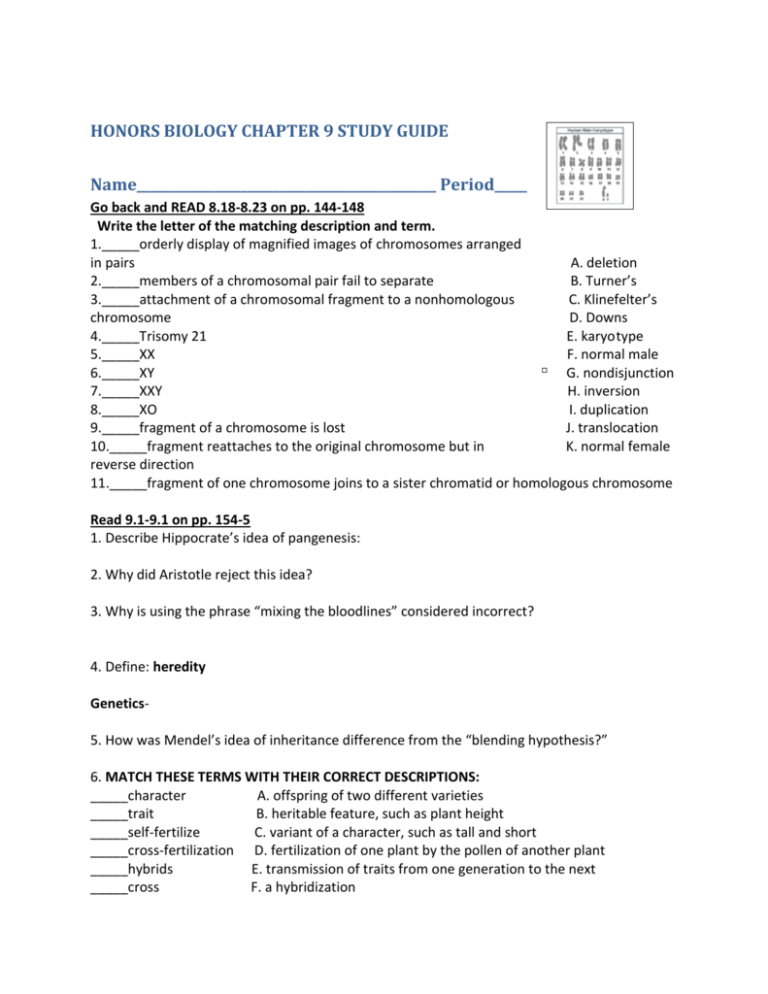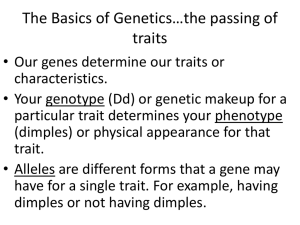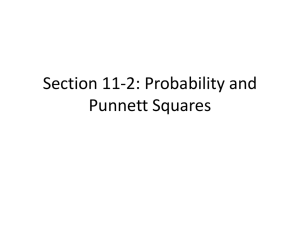In the Punnett square to the left if A= argyle and a=amber, what is
advertisement

HONORS BIOLOGY CHAPTER 9 STUDY GUIDE Name______________________________________________ Period_____ Go back and READ 8.18-8.23 on pp. 144-148 Write the letter of the matching description and term. 1._____orderly display of magnified images of chromosomes arranged in pairs A. deletion 2._____members of a chromosomal pair fail to separate B. Turner’s 3._____attachment of a chromosomal fragment to a nonhomologous C. Klinefelter’s chromosome D. Downs 4._____Trisomy 21 E. karyotype 5._____XX F. normal male 6._____XY G. nondisjunction 7._____XXY H. inversion 8._____XO I. duplication 9._____fragment of a chromosome is lost J. translocation 10._____fragment reattaches to the original chromosome but in K. normal female reverse direction 11._____fragment of one chromosome joins to a sister chromatid or homologous chromosome Read 9.1-9.1 on pp. 154-5 1. Describe Hippocrate’s idea of pangenesis: 2. Why did Aristotle reject this idea? 3. Why is using the phrase “mixing the bloodlines” considered incorrect? 4. Define: heredity Genetics5. How was Mendel’s idea of inheritance difference from the “blending hypothesis?” 6. MATCH THESE TERMS WITH THEIR CORRECT DESCRIPTIONS: _____character A. offspring of two different varieties _____trait B. heritable feature, such as plant height _____self-fertilize C. variant of a character, such as tall and short _____cross-fertilization D. fertilization of one plant by the pollen of another plant _____hybrids E. transmission of traits from one generation to the next _____cross F. a hybridization Honors Biology Study Guide 9 p. 2 7. Label the cross of plants in the diagram to the left in the boxes: F1, P, F2 8. Write D if the trait is dominant an R if the trait is recessive (Fig. 9.2D): _____purple _____white _____axial _____terminal _____green _____yellow _____dwarf _____tall _____round _____wrinkled Read 9.3-9.4 on pp. 156-7 1. A __________________________--cross differs in only one trait. 2. There are alternate versions of genes called _________________. 3. For each character an organisms inherits how many alleles?_______ If the alleles are identical (like TT or tt) they are said to be ___________________________-if they are different (like Tt) they are said to be _________________________. 4. If the alleles are different, the one that determines the trait is said to be _________________ (usually written as a capital letter), which the one not determining the trait (usually written as a lowercase letter) is________________________. 5. Allele pairs separate during the production of gametes according to the Law of ___________. 6. A diagram showing the possible combinations of alleles when gametes combine is known as a: _________________________ _______________________ 7. An organism’s physical traits are known as its:________________________________ An organism’s genetic makeup is known as its:________________________________ In the Punnett square to the left if A= argyle and a=amber, what is the ratio of argyle to amber offspring? 8. Honors Biology Chapter 9 Study Guide p. 3 9. Draw an example of two homologous chromosomes with three loci of genes, that are in the same locations, but heterogygous for A, homozygous for b, and heterozygous for C. Read 9.5 – 9.5 on pp. 158-9 1. For a dihybrid cross, how many boxes are needed for a Punnett square?_______ 2. Using Fig. 9.5A as a guide draw a dihybrid cross with the sperm and egg gamete possibilities on the left and top sides of the Punnett square. 3. What is the Law of Independent Assortment? 4. Looking at Fig 9.5B, what do you think it means when a genotype is written as B_N_? 5. If you had a Labrador retriever with a chocolate coat, what is its genotype?___________ If you had a Labrador retriever with a black coat, what genotypes are possible?____________ 6. If you had a black Labrador retriever how could you find out what genotype it really has? Read 9.7 p. 160 1. Mendel applied the rules of probability to inheritance. How does the size of the samples affect the results? 2. The event is certain to happen is given what number?_____ An even certain NOT to happen is given what number?____ A tossed coin has what fraction of a chance to be a heads?______ A tossed coin has what fraction of a chance to be a tails?_______ The probabilities of all possible outcomes for an event to occur must add up to ____ What is the probability of rolling a “2” on a die?_____ How does the toss on a coin affect what you will get on the second toss?___________________ Honors Biology Chapter 9 Study Guide p. 4 3. Define: the rule of multiplication (and give an example)- 4. If you are crossing Tt X Tt what is the chance of having a “t “ in each Tt?_____ What would be the probability of having a “tt” from this cross?___________ (show your work) 5. Define: rule of addition (and give an example)- 6. Using the example on p. 160, calculate what the probability of having a AABbCc offspring of parents both AaBbCc: Read 9.8 on p. 161 1. What are wild-type traits? Are wild-type traits always dominant? 2. What is a pedigree? Identify what is the symbol used for these parts of a pedigree: (see fig. 9.8B) _____male _____matings _____female _____offspring _____person with the trait Read 9.9 on pp. 161-162 Match the disorder with its description: 1._____recessive, lipid accumulation on brain, death in childhood 2._____dwarfism 3._____excess cholesterol in blood 4._____lack of pigment in skin, eyes, hair 5._____Curved red blood cells 6._____accumululation of galactose in tissues, mental retardation 7._____mental deterioration, uncontrollable movement, in adult 8._____Accumulation of phenylalanine in blood, mental retardation 9._____Excess mucus in lungs, digestive tract, increased infections 10._____Mental deterioration; usually strikes late in life. A. Huntington’s B. cystic fibrosis C. Sickle-cell anemia D. Alzheimer’s E. Achrondroplasia F. Tay Sachs G. Hypercholesterolemia H. Albinism I. Galactosemia J. PKU Read 9.10 on pp. 164-165 1. Women who are over the age of __________have a high risk of having a child with Down’s. 2. How is an amniocentesis performed? Why? Honors Biology Chapter 9 Study Guide p. 5 4. What kind of things can a blood test show about genetic disorders? 5. How does ultrasound imaging work? What advantage does it have other the methods listed above? 6. What advantage is a PKU test on a newborn? 7. List at least 3 ethical considerations before doing a fetal test: Read 9.11 p. 166-7 1. Define: complete dominance (give example) 2. Define: incomplete dominance (give example) 3. Why does incomplete dominance not support the “blending theory?” Read 9.12 p. 167 1. Blood typing is an example of multiple alleles. List the 4 phenotypes of human blood: List the possible genotypes of each of the phenotypes. (see fig. 9.12) 2. What blood type shows codominance? The antigens are the “carbohydrates” on the surface of the red blood cell. If the antigen is in the presence of the antibody of the same letter, clumping will occur. Can blood type O be safely given to blood type AB? Why or why not? Honors Biology Chapter 9 Study Guide p. 6 Read 9.13 p. 168 1. What is pleiotropy? (give an example) 2. List at least 5 symptoms of sickle-cell disease: 3. Make a Punnett square prediction of the offspring if AA = normal, SS= sickle cell disease, an AS = usually healthy, carrier, resistant to malaria if the parents are AA and AS. Read 9.14 p. 169 1. Describe polygenic inheritance (give example) 2. A person with skin AaBbcc would have a skin color the same as what other combination? (list at least two) Read 9.15-16 pp. 170-171 1. What might affect the color of a person’s skin other than the genotype? 2. What might affect how two identical twins look? 3. What is the chromosome theory of inheritance? 4. Which of Mendel’s laws have their physical basis in the following phases of meiosis: (a) the orientation of homologous chromosome pairs in metaphase I (b) the separation of monologs in anaphase I? Honors Biology Chapter 9 Study Guide p. 7 Read 9.17-9.18 pp. 172-173 1. When Bateson and Punnett noticed that the numbers of certain genes are found on the same chromosome and inherited together, they are known as _________________genes. 2. In Fig. 9.17 what discrepancy in the “predicted” pea traits and the “observed” traits is noticed? 3. Thomas Hunt Morgan used fruit flies called _____________________ __________________. 4. If genes are NOT LINKED what is the expected phenotypic ratio of heterozygous gray fly with long wings with a black fly with vestigial wings?______________________________________ 5. What is recombinant frequency? 6. To calculate the recombination frequency use the total number of recombinants (nonparentals) divided by total number of progeny. Return to the data in Fig. 19.7 what is the recombination frequency of the plants that are not the same as the parents (purple long and red round)? Read 9.19 on p. 174 1. Alfred Sturtevant used crossover data to map gene loci. According to him the ___________ the distance between two genes, the __________points there are between them where crossing over can occur. 2. What is a linkage map? 3. Look at Fig. 9.19A. Where would gene recombination frequencies (gene B) of 5% recombination frequency with the (l) gene and 4% recombination frequency with the (c) gene. Where is the gene B located? Read 9.20 on pp. 174-5 1. Which types of organisms have XX chromosomes?_____________XY?___________ 2. What is the SRY? 3. How do the grasshoppers and roaches sex chromosomes appear? 4. How do the birds and butterflies sex chromosomes appear? Honors Biology Chapter 9 Study Guide p. 8 5. How is sex determined in bees and ants? 6. How does temperature affect the sex of some reptiles? Read 9.21 on p. 176 1. A gene that is located on the X-chromosome is known as a _______________________gene. 2. How would you write the genotype of a sex-linked gene? 3. Make a Punnett square of the cross of XHXh with XhY: Read 9.22-23 on p. 177 1. Describe the symptoms of each of these sex-linked genetic disorders: Hemophilia Red-green colorblindness Duchenne muscular dystrophy 2. Why is the Y chromosome particularly useful in tracing human heritage?








